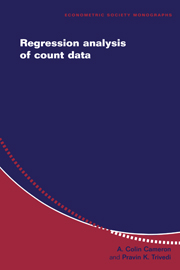Book contents
- Frontmatter
- Contents
- List of Figures
- List of Tables
- Preface
- 1 Introduction
- 2 Model Specification and Estimation
- 3 Basic Count Regression
- 4 Generalized Count Regression
- 5 Model Evaluation and Testing
- 6 Empirical Illustrations
- 7 Time Series Data
- 8 Multivariate Data
- 9 Longitudinal Data
- 10 Measurement Errors
- 11 Nonrandom Samples and Simultaneity
- 12 Flexible Methods for Counts
- Appendices
- References
- Author Index
- Subject Index
- Titles in the series
5 - Model Evaluation and Testing
Published online by Cambridge University Press: 05 January 2013
- Frontmatter
- Contents
- List of Figures
- List of Tables
- Preface
- 1 Introduction
- 2 Model Specification and Estimation
- 3 Basic Count Regression
- 4 Generalized Count Regression
- 5 Model Evaluation and Testing
- 6 Empirical Illustrations
- 7 Time Series Data
- 8 Multivariate Data
- 9 Longitudinal Data
- 10 Measurement Errors
- 11 Nonrandom Samples and Simultaneity
- 12 Flexible Methods for Counts
- Appendices
- References
- Author Index
- Subject Index
- Titles in the series
Summary
Introduction
It is desirable to analyze count data using a cycle of model specification, estimation, testing, and evaluation. This cycle can go from specific to general models – for example, it can begin with Poisson and then test for negative binomial – or one can use a general to specific approach – for example, begin with negative binomial and then test the restrictions imposed by Poisson. For inclusion of regressors in a given count model either approach might be taken; for choice of the count data model itself other than simple choices such as Poisson or negative binomial the former approach is most often useful. For example, if the negative binomial model is inadequate, there is a very wide range of models that might be considered, rendering a general-to-specific approach difficult to implement.
The preceding two chapters have presented the specification and estimation components of this cycle for cross-section count data. In this chapter we focus on the testing and evaluation aspects of this cycle. This includes residual analysis, goodness-of-fit measures, and moment-based specification tests, in addition to classical statistical inference.
Residual analysis, based on a range of definitions of the residual for heteroskedastic data such as counts, is presented in section 5.2. A range of measures of goodness of fit, including pseudo R-squareds and a chi-square goodness-of-fit statistic, are presented in section 5.3. Likelihood-based hypothesis tests for overdispersion, introduced in section 3.4, are discussed more extensively in section 5.4. Small-sample corrections, including the bootstrap pairs procedure for quite general cross-section data models, are presented in section 5.5.
- Type
- Chapter
- Information
- Regression Analysis of Count Data , pp. 139 - 188Publisher: Cambridge University PressPrint publication year: 1998



